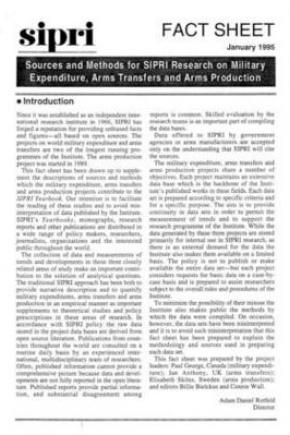Sources and Methods for SIPRI Research
Since it was established as an independent international research institute in 1966, SIPRI has forged a reputation for providing unbiased facts and figures—all based on open sources. The projects on world military expenditure and arms transfers are two of the longest running programmes of the Institute. The arms production project was started in 1989.
This Fact Sheet has been drawn up to supplement the descriptions of sources and methods which the military expenditure, arms transfers and arms production projects contribute to the SIPRI Yearbook. Our intention is to facilitate the reading of these studies and to avoid misinterpretation of data published by the Institute, SIPRI's Yearbooks, monographs, research reports and other publications are distributed to a wide range of policy makers, researchers, journalists, organizations and the interested public throughout the world.
The collection of data and measurements of trends and developments in these three closely related areas of study make an important contribution to the solution of analytical questions. The traditional SIPRI approach has been both to provide narrative description and to quantify military expenditures, arms transfers and arms production in an empirical manner as important supplements to theoretical studies and policy prescriptions in these areas of research. In accordance with SIPRI policy the raw data stored in the project databases are derived from open source literature. Publications from countries throughout the world are consulted on a routine daily basis by an experienced international, multidisciplinary team of researchers. Often, published information cannot provide a comprehensive picture because data and developments are not fully reported in the open literature. Published reports provide partial information, and substantial disagreement among reports is common. Skilled evaluation by the research teams is an important part of compiling the databases.
Data offered to SIPRI by government agencies or arms manufacturers is accepted only on the understanding that SIPRI will cite the sources.
The military expenditure, arms transfers and arms production projects share a number of objectives. Each project maintains an extensive database which is the backbone of the Institute's published works in these fields. Each data set is prepared according to specific criteria and for a specific purpose. The aim is to provide continuity in data sets in order to permit the measurement of trends and to support the research programme of the Institute. While the data generated by these three projects is stored primarily for internal use in SIPRI research, as there is an external demand for the data the Institute also makes them available on a limited basis. The policy is not to publish or make available the entire data set, but each project considers requests for basic data on a case-by-case basis and is prepared to assist researchers subject to the overall rules and procedures of the Institute.
To minimize the possibility of their misuse the Institute also makes public the methods by which the data were compiled. On occasion, however, the data sets have been misinterpreted and it is to avoid such misinterpretation that this Fact Sheet has been prepared to explain the methodology and sources used in preparing each data set.
1. Introduction
2. Military Expenditure
3. Arms Transfers
4. Arms Production


